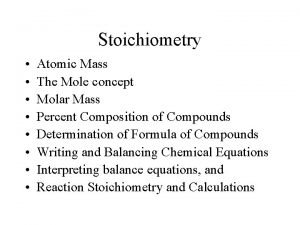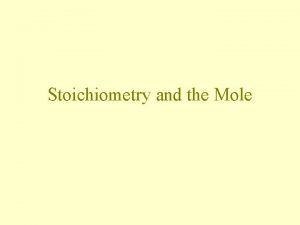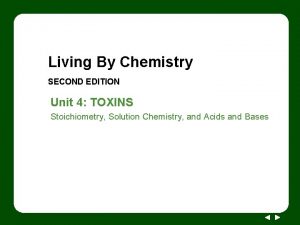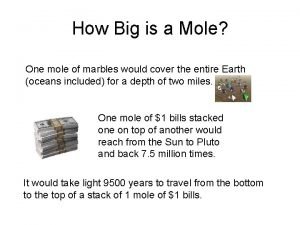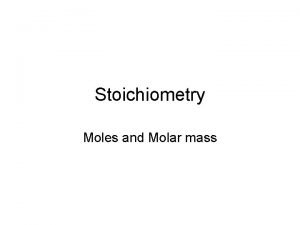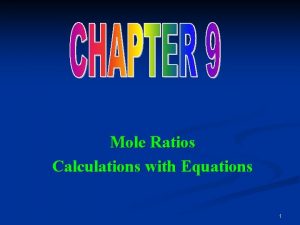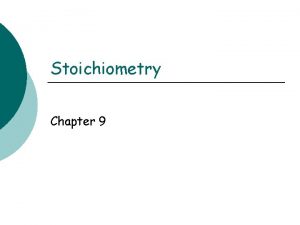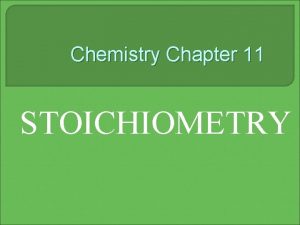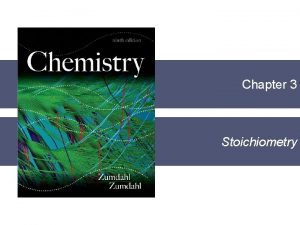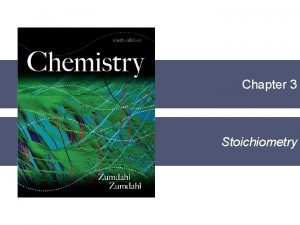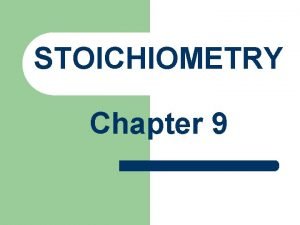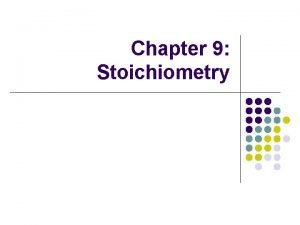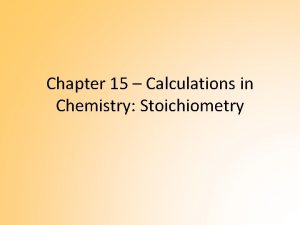MOLE CONCEPT STOICHIOMETRY CHEMISTRYX CHAPTER 4 Mole Concept














- Slides: 14

MOLE CONCEPT & STOICHIOMETRY CHEMISTRY-X CHAPTER 4

Mole Concept Gas Laws • • • Boyle’s law: The volume of a given mass of a dry gas is inversely proportional to its pressure at constant temperature. V ∞ 1/ P [ T = const. ] Charle’s law: The volume of a given mass of a dry gas is directly proportional to its temperature at constant pressure. V ∞ T [ P = const. ] The Gas Equation: Combining Boyle’s Law and Charle’s Law: The volume of a given mass of a dry gas varies inversely with pressure and directly with absolute temperature. V ∞ 1/P x T or, V = T/P x const. Or, PV/T = k (const. ) Standard Temperature = 0°C =273 K Standard Pressure = 760 mm of Hg = 76 cm of Hg = 1 atmospheric pressure.

Gay-Lussac’s Law: “When gases react, they do so in volumes which bear simple whole number ratio to one another and to the volume of the products, if gaseous, provided the temperature and pressure of reacting gases and their products remain constant. ”

Avogadro’s Law Introduction

Relative Atomic Mass & Relative Molecular Mass Gram Atomic Mass (Gram Atom): The relative atomic mass of an element expressed in grams. Gram Molecular Mass (Gram Molecule): The relative molecular mass of an element expressed in grams.

Mole & Avogadro's Number v. A mole is a collection of particles(basic unite - atoms, molecules, ions) or amount of substance containing particles equal to 6. 023 x 1023 i. e. Avogadro’s number. v. Avogadro's number is the number of elementary units i. e. Atoms, molecules or Ions in one mole of a substance. v. Avogadro’s number is denoted by NA or L.

Applications of Avogadro’s law 1. Determining Atomicity of a gas. 2. Explains Gay-Lussac’s law of combining volumes

Applications of Avogadro’s law 3. Determining the relation between molecular weight and vapour density

Applications of Avogadro’s law 4. Determining molecular formula of a gas 5. Determining relation between gram molecular weight and gram molecular volume

Stoichiometry




THE END ~ Rajshree Ranjana
 Mole problem
Mole problem Stoichiometry worksheet #2 (mole-mass mass-mole problems)
Stoichiometry worksheet #2 (mole-mass mass-mole problems) Phosphorus with oxygen equation
Phosphorus with oxygen equation Stoichiometry mole-mole
Stoichiometry mole-mole Stoichiometry mole island diagram
Stoichiometry mole island diagram Mole tunnel stoichiometry
Mole tunnel stoichiometry Mole island
Mole island Stoichiometry island diagram
Stoichiometry island diagram Mole mole factor
Mole mole factor Convert mass to moles
Convert mass to moles Mole-mass-volume relationships
Mole-mass-volume relationships Chapter 11 study guide stoichiometry
Chapter 11 study guide stoichiometry Chemistry chapter 9 stoichiometry
Chemistry chapter 9 stoichiometry Chapter 9 review stoichiometry modern chemistry answers
Chapter 9 review stoichiometry modern chemistry answers Chemical equation defintion
Chemical equation defintion


